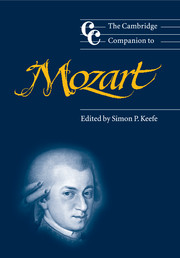14 - Mozart and the twentieth century
from Part III - Reception
Published online by Cambridge University Press: 28 September 2011
Summary
At the end of his novel Lucia in London, E. F. Benson's heroine, the energetic socialite Emmeline Lucas – Lucia to her friends – suggests to her piano-duet partner, Georgie Pilson, that they have half an hour's practice of ‘celestial Mozartino’. In Lucia's cosmology of composers Bach is ‘glorious’, Scarlatti ‘dainty’ and Beethoven ‘noble’, but only Mozart achieves divine, if diminutive, status. Lucia's Mozart is the infant prodigy beloved of the nineteenth century, when, at various stages, England's cultured classes were hot on the trail of successors to the Salzburg genius. Perhaps this is not surprising, since the biographies to which Benson would have had access made much of the infant: for example, Lady Wallace's 1877 translation of Ludwig Nohl's The Life of Mozart, which has the child Mozart in Austrian court dress as a frontispiece, or Pauline Townsend's translation of Otto Jahn's monumental Life of Mozart published by Novello in 1891, which uses an engraving of Mozart derived from the Verona portrait of 1770.
Nearly twenty years after Benson published Lucia in London, van Loon Invited Mozart, along with St Francis of Assisi and Hans Andersen, to dinner in his volume of fantasy encounters, Van Loon's Lives. His account of Mozart is a flight of fancy based on conventional popular images; Constanze, for example, is described as ‘flighty’ and ‘rather worthless’. There is an emphasis on the purity of the composer's inspiration and the ability of his music to connect the listener with childhood: ‘a source of everlasting inspiration and joy for those who have not yet forgotten the laughter and the simple pleasures of their childhood days’.
- Type
- Chapter
- Information
- The Cambridge Companion to Mozart , pp. 185 - 199Publisher: Cambridge University PressPrint publication year: 2003
- 1
- Cited by

